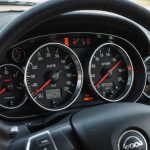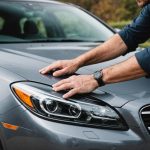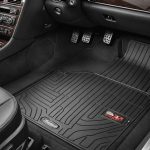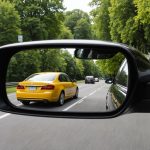Mastering Blind Spot Safety: The Ultimate Guide to Adjusting Hatchback Side Mirrors for Maximum Visibility
Understanding the Importance of Blind Spot Safety
When it comes to driving, one of the most critical aspects of road safety is managing blind spots. These are areas around your vehicle that you cannot see through your rear view or side mirrors, and they can pose a significant risk, especially during lane changes, parking, and other maneuvers. Here’s why blind spot safety is so crucial:
- Reducing Accidents: Blind spots can hide other vehicles, pedestrians, or obstacles, leading to potential collisions. By adjusting your side mirrors correctly, you can minimize these risks.
- Enhancing Visibility: Properly adjusted mirrors provide a wider field of view, helping you stay aware of your surroundings and react promptly to changes in traffic.
- Compliance with Driving Standards: For learner drivers, mastering blind spot management is a key part of the driving curriculum. It’s essential for passing driving tests and becoming a safe and competent driver.
How to Adjust Your Side Mirrors for Maximum Visibility
Adjusting your side mirrors is not just about tilting them to see the rear of your car; it’s about creating a seamless field of view that minimizes blind spots.
Topic to read : Essential Guide: Safely Replacing Your Rearview Mirror in ADAS-Equipped Vehicles
The “SWEPT” Method
One effective technique for adjusting your side mirrors is the “SWEPT” method, which stands for Set your mirrors to show just a sliver of your car, Widen your field of view, Eliminate blind spots, Position for comfort, and Test your setup.
- Set Your Mirrors: Start by adjusting your side mirrors so that you can just see the edge of your car. This ensures that your mirrors are not overlapping with your rear view mirror.
- Widen Your Field of View: Adjust the mirrors outward to capture as much of the adjacent lanes as possible. This helps in detecting vehicles in your blind spots.
- Eliminate Blind Spots: The goal is to create a continuous field of view from your rear view mirror to your side mirrors. This way, you can see vehicles moving into your blind spots.
- Position for Comfort: Ensure that your mirrors are adjusted in a way that you can see clearly without straining or adjusting your seating position.
- Test Your Setup: Drive in different conditions to test your mirror adjustments. Make lane changes, check your mirrors frequently, and perform shoulder checks to ensure you have optimal visibility.
Techniques for Effective Blind Spot Management
Managing blind spots is not just about adjusting your mirrors; it involves a combination of techniques and habits.
In the same genre : Exploring the Impact of Tire Compounds on Vehicle Handling Across Varied UK Weather Conditions
Shoulder Checks
Shoulder checks, or blind spot checks, are essential for ensuring that your blind spots are clear before making any lane changes or maneuvers.
- Why Shoulder Checks Are Important: Even with perfectly adjusted mirrors, there can still be small blind spots. A quick shoulder check can reveal vehicles or obstacles that your mirrors might miss.
- How to Perform a Shoulder Check: Turn your head to look over your shoulder, checking the blind spot area directly. This should be done quickly and smoothly to avoid distracting you from the road.
Lane Changes and Blind Spots
Lane changes are one of the most common times when blind spots become critical.
- Signal Early: Always signal your intention to change lanes well in advance to alert other road users.
- Check Your Mirrors and Blind Spots: Before changing lanes, check your rear view mirror, side mirrors, and perform a shoulder check to ensure your blind spots are clear.
- Adjust Your Speed: Match your speed to the lane you are entering to avoid disrupting the flow of traffic.
Practical Tips for Safe Driving
Here are some practical tips to help you master blind spot safety:
Regular Mirror Checks
- Frequency: Check your mirrors every 5-10 seconds to stay aware of your surroundings.
- Comprehensive Checks: Include rear view, side mirrors, and a quick shoulder check in your routine.
Use of Blind Spot Detection Systems
Many modern vehicles come equipped with blind spot detection systems. These systems use sensors to detect vehicles in your blind spots and alert you through lights or alarms.
- How It Works: These systems typically monitor the areas around your vehicle and alert you if a vehicle is detected in your blind spot.
- Benefits: They can enhance safety, especially for drivers who are new to managing blind spots or for those driving in heavy traffic.
Parking and Blind Spots
Even when parking, blind spots can be a hazard, especially when parallel parking.
- Use Your Mirrors and Looking Over Your Shoulder: When parallel parking, use your mirrors and perform shoulder checks to ensure there are no pedestrians or vehicles in your blind spots.
- Check for Obstacles: Look for any obstacles or other vehicles that might be hidden from your view.
Table: Comparison of Blind Spot Management Techniques
| Technique | Description | Benefits |
|---|---|---|
| SWEPT Method | Adjust mirrors to show just a sliver of your car, widen field of view, eliminate blind spots, position for comfort, and test setup. | Provides a seamless field of view, minimizes blind spots. |
| Shoulder Checks | Turn your head to look over your shoulder to check blind spots. | Ensures blind spots are clear before lane changes or maneuvers. |
| Blind Spot Detection Systems | Uses sensors to detect vehicles in blind spots and alerts the driver. | Enhances safety, especially in heavy traffic or for new drivers. |
| Regular Mirror Checks | Check mirrors every 5-10 seconds to stay aware of surroundings. | Keeps you informed about your surroundings and potential hazards. |
| Lane Change Procedures | Signal early, check mirrors and blind spots, adjust speed to match the lane. | Reduces the risk of accidents during lane changes. |
Quotes from Driving Experts
- “Properly adjusted mirrors are the first line of defense against blind spots. However, no mirror adjustment can completely eliminate blind spots, which is why shoulder checks are so important.” – John Smith, Driving Instructor
- “Blind spot detection systems are a game-changer for safety. They provide an additional layer of protection and can be particularly useful for drivers who are still learning to manage their blind spots.” – Jane Doe, Automotive Safety Expert
Mastering blind spot safety is a crucial aspect of driving that can significantly reduce the risk of accidents and enhance your overall driving experience. By adjusting your side mirrors using the SWEPT method, performing regular shoulder checks, and utilizing blind spot detection systems, you can ensure maximum visibility and safety on the road.
Detailed Checklist for Adjusting Side Mirrors
Here is a detailed checklist to help you adjust your side mirrors correctly:
- Step 1: Adjust the Mirror Height
- Ensure the mirror is at a height where you can see the horizon.
- This helps in aligning your view with the road ahead.
- Step 2: Adjust the Mirror Angle
- Tilt the mirror so that you can just see the edge of your car.
- This ensures that your mirrors are not overlapping with your rear view mirror.
- Step 3: Widen Your Field of View
- Adjust the mirrors outward to capture as much of the adjacent lanes as possible.
- This helps in detecting vehicles in your blind spots.
- Step 4: Eliminate Blind Spots
- Adjust the mirrors to create a continuous field of view from your rear view mirror to your side mirrors.
- This way, you can see vehicles moving into your blind spots.
- Step 5: Position for Comfort
- Ensure that your mirrors are adjusted in a way that you can see clearly without straining or adjusting your seating position.
- Comfort is key to maintaining focus on the road.
- Step 6: Test Your Setup
- Drive in different conditions to test your mirror adjustments.
- Make lane changes, check your mirrors frequently, and perform shoulder checks to ensure you have optimal visibility.
By following these steps and incorporating the techniques mentioned above, you can significantly enhance your blind spot safety and become a more confident and safe driver.











